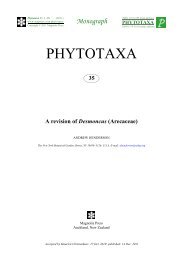Zootaxa, Taxonomy of Serpulidae (Annelida ... - Magnolia Press
Zootaxa, Taxonomy of Serpulidae (Annelida ... - Magnolia Press
Zootaxa, Taxonomy of Serpulidae (Annelida ... - Magnolia Press
You also want an ePaper? Increase the reach of your titles
YUMPU automatically turns print PDFs into web optimized ePapers that Google loves.
lacks a phylogenetic basis. See further remarks for Spirobranchus. SEM photos <strong>of</strong> Pomatoleios are published<br />
in Fiege & Sun (1999).<br />
Pomatoleios kraussii (Baird, 1865), South Africa; widely distributed in the Indo-Pacific; Lessepsian migrant<br />
to the Levant Mediterranean.<br />
32. Pomatostegus Schmarda, 1861<br />
(Fig. 37)<br />
Type-species: Pomatostegus macrosoma Schmarda, 1861, junior synonym <strong>of</strong> Terebella stellata Abildgaard, 1789<br />
Number <strong>of</strong> species: 3<br />
Tube white, opaque, semi-circular to roughly triangular in cross-section, with up to 5 longitudinal keels;<br />
granular overlay absent. Operculum a very flat ampulla covered with chitinous disk bearing a column with<br />
several serrated disks alternating with circlets <strong>of</strong> spines proximally and closely applied to each disk. Peduncle<br />
flatly triangular in cross-section with broad latero-distal wings along its entire length; inserted to the left or<br />
right at the basis <strong>of</strong> the branchial lobe; from the fact that the first and second radiole separated by the base <strong>of</strong><br />
the peduncle, it is inferred that it is derived from the second normal radiole. Constriction absent.<br />
Pseudoperculum absent. Arrangement <strong>of</strong> radioles in (semi-)circles, up to 90 per lobe. Inter-radiolar membrane<br />
present. Branchial eyes present. Stylodes absent. Mouth palps absent. 7 thoracic chaetigerous segments.<br />
Collar tri- to penta-lobed, well developed with an entire smooth margin. Tonguelets absent. Thoracic<br />
membranes short, ending just posterior to the second row <strong>of</strong> uncini (segment 3). Collar chaetae<br />
Spirobranchus-type, with basal pilose fin and distal blade, and limbate (Fig. 37B). Apomatus chaetae present<br />
(Fig. 37E). Thoracic uncini saw-shaped, with 9–13 teeth, anterior peg blunt (Fig. 37C). Thoracic tori meet<br />
ventrally in larger specimens; in juveniles the ventral space between thoracic tori narrowing towards last rows<br />
that almost fused, leaving a triangular depression. Abdominal chaetae flat narrow geniculate, with long blade<br />
(Fig. 37F). Abdominal uncini smaller than thoracic ones, with about 8 teeth in pr<strong>of</strong>ile, 3 teeth in a row (Fig.<br />
37D). Achaetous anterior abdominal zone absent. Long posterior capillary chaetae absent, but posterior<br />
chaetae longer. Posterior glandular pad absent.<br />
Remarks. According to the recent literature there is but a single circumtropical species, Pomatostegus<br />
stellatus. However, an unpublished study by P. Valentijn (former student to HAtH, University Utrecht), reinstigated<br />
two species regarded to be synonymous with the type-species to full specific rank: P. actinoceras,<br />
from the Indo-West Pacific Region, and P. krøyeri, from tropical Pacific America, leaving a tropical Atlantic<br />
distribution only for P. stellatus. The latter taxon has been recorded from Atlantic Africa by Augener (1918),<br />
Amoureux (1973), and Zibrowius (1973b), however, the single specimen studied from Western Africa by<br />
Valentijn and ten Hove could not be attributed with certainty to either P. actinoceras (likely) or P. stellatus<br />
(less likely).<br />
1. Pomatostegus actinoceras Mörch, 1863, Indo-West Pacific, ?Western Africa; generally synonymised with<br />
P. stellatus<br />
2. Pomatostegus krøyeri Mörch, 1863, tropical Pacific America; generally synonymised with P. stellatus<br />
3. Pomatostegus stellatus (Abildgaard, 1789), West Indies; Caribbean; usually including preceding 2 species.<br />
33. Protis Ehlers, 1887<br />
(Fig. 38)<br />
Type-species: Protis simplex Ehlers, 1887<br />
Number <strong>of</strong> species: 6 (or 7)<br />
78 · <strong>Zootaxa</strong> 2036 © 2009 <strong>Magnolia</strong> <strong>Press</strong><br />
TEN HOVE & KUPRIYANOVA
















